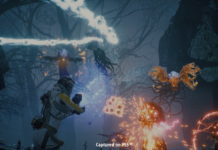Sleep is Death (a.k.a. Geisterfahrer) is a game that takes some explaining – not least because of the rather self-consciously artsy title. If the name does tell you anything, it’s that you should expect something a little outside the norm. In fact, Sleep is Death, while smartly borrowing the aesthetics of the 8-bit era, is barely definable as a game at all.
Here’s how Sleep is Death (SiD) works. Player 1 either draws a background, such as a pixel-art supermarket, or assembles one from the numerous tiles and presets provided with the game, and available on the net. They populate the landscape with a few objects and character sprites, and choose one character to represent the second player. The game is apparently designed for LANs, but I suspect the majority of play comes from internet games or from two local players taking turns with a single PC. When a connection is made with Player 2, a “game” begins in earnest.
Player 1 is essentially the man behind the curtain, manipulating the objects and environments of the game. He’ll often kickstart the collaborative storytelling by typing speech for one of the sprites he has placed in the scene. Player 2 has one character, which can move around the scene, talk, and interact with other objects and characters. Together, the players tell a short story, or, as more often is the case, Player 1 tries to tell a story while Player 2 tries to be as disruptive as possible. But it’s still the first player, the host, who holds the god-like power to change the world at will, moving characters and switching between scenes in response to the protagonist’s actions.
The only restriction; each turn lasts 30 or 60 seconds, meaning the pressure is on, especially for the host, to shuffle sprites around and write lines of speech before the time runs out. While Oscar-winning dialogue is generally off the menu, this rather convoluted method of telling – and experiencing – a story can produce charming, funny, strange, and occasionally inspired results. It is the video game equivalent of an exquisite corpse, or improvised comedy on a computer screen.
Whatever you choose to compare it to, SiD is a uniquely strange experiment. SiD is already supported by a burgeoning community, including sidtube.com, which allows you to share your “flipbooks” (shot by shot records of your creations) with the public, set up games and upload resource packs. And that’s good news, because Sleep is Death is one of those games – like Little Big Planet, or Spore – that lives or dies on the strength of the user-generated content.
Unfortunately, the software itself is a little idiosyncratic. Entirely the work of designer Jason Rohrer, SiD can be confusing, limited, and obtuse. You can’t import pictures unless you download a fan made add-on. SiD also assumes a working knowledge of computing. For example: changing settings requires you to manually edit .ini files, and setting the game up to work on the internet, while not particularly odious, is fifteen years behind the hand-holding set-ups and smart matchmaking of Steam or Live. This is a shame, because SiD is a great crossover concept, which seems ideally suited to draw new, non-technophile audiences into gaming. Mr. Rohrer is an extraordinarily talented programmer and great at using his own game, and unfortunately he expects a similar level of proficiency and quick-wittedness from his audience, much to the detriment of the game’s wider appeal.
It is very difficult to draw a vaguely humanoid sprite in 30 seconds, unless you have a mouse-hand like a hummingbird. Then there’s the game’s strangest curse/blessing – the 8-bit look. This is an inspired choice because the pixel limit makes it plausible to rearrange and position screen elements precisely within the time limit, and plan out new scenarios in hours rather than days. The problem is that the low resolution is carried over to the creation interface, which is full of tiny, unreadable icons and hidden functions that are hard for a newcomer to make best use of. Thankfully, there are decent video tutorials, narrated by the designer, and a fan made wiki is coming along nicely.
How much you get out of Sleep is Death is entirely correlated to the effort you’re prepared to put in. Spend a while learning the awkward interface, create your dream scenario, and hook up with a smart player (My friend and I had great fun with the misadventures of a misanthropic comedian and a psychological thriller set at a carnival) and you can enjoy hours of one-of-a-kind storytelling. Go in blind, play with a monomaniacal Nintendo fanboy and expect complete frustration.
Sleep is Death is a great idea with a sturdy toolset for user-generated content. The pay-what-you want price point only sweetens the deal. I still don’t know what the title means (“Geisterfahrer” is a German term for a suicidal motorist going the wrong way up the Autobahn, apparently) but I sure as hell don’t care. In fact, the one thing you won’t do in this game is sleep, as the time-limit tension makes every storytelling collaboration a nerve-wracking, but often rewarding experience.









